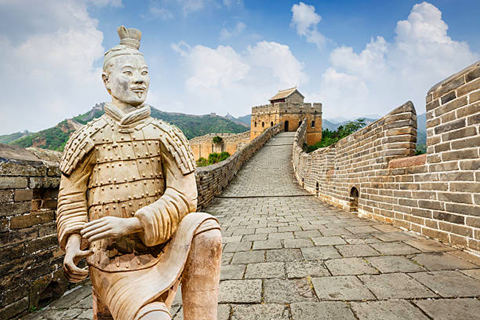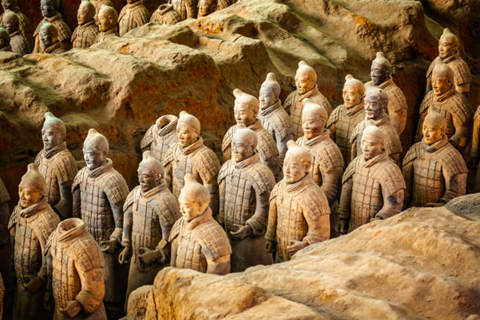
Our previous article, My Journey to Henan Museum written by Yang LIANG, has been invitingly responded with a new but related article contributed by a current MA in Irish Studies postgraduate at QUB, Martin Duffy, who, with great interest, shared his experience and perspective of visiting the Mausoleum of the First Qin Emperor and the Terracotta Warriors in his early years when visiting Xi’an, China.
[The author happily acknowledges the copyright of all videos and pictures included in this article which are reproduced under fair use policy for educational purposes only.]
This is undoubtedly one of the “must see” sights of China. Tickets can be obtained by web, agent or at the admissions desk, and there are a variety of discounts. The Great Wall of China was augmented by the emperor to protect the newly founded Qin dynasty (221–206 BC.). In many ways this is Emperor Qin’s greatest legacy. However, the Emperor’s personal mausoleum and world-famous Terracotta Warriors are treasures to rival even the Great Wall.
Martin duffy
As a child I was fascinated by the magnificent Terracotta Army (兵马俑). Soon this great treasure of world history was also on our television screens and the first of many international tours across the globe commenced. Like many of the world’s great archaeological finds, the Army was discovered by chance. In 1974, farmers found the site which was eventually to reveal some 8,000 terracotta warriors close to Xi’an City. The first emperor of Qin, or known by Chinese as Qinshihuang (秦始皇), ended almost four hundred years of Warring States (战国) and wanted to extend his rule to eternity. The vast army of clay warriors was assembled with an intention to protect the emperor forever. Now the Mausoleum is one of the most visited of UNESCO World Heritage Sites, and the Lintong District in Xi’an has been transformed into a museum hub, in the space of a decade.
As I discovered for myself in 1992 when I first visited China, Qin funerary art is beautiful. The artefacts at the Mausoleum include warriors, chariots, and military horses. Archaeologists have found figures of all the other functionaries the emperor would need in his afterlife, including even entertainers and musicians.
While the find was accidental, the emperor’s grand tomb had been described by historian Sima Qian (145–90 BCE) in Records of the Grand Historian, the first of China’s numerous dynastic histories. Work on the mausoleum began in 246 BCE soon after Emperor Qin (then aged 13) became Emperor. The location of Mount Li was chosen because of its association with jade and gold deposits. The necropolis was constructed as a microcosm of the emperor’s imperial palace. The tomb constitutes a hermetically sealed space the size of a soccer football pitch and remains unopened, due to preservation concerns.
The terracotta figures are life-sized. Originally painted, in Xi’an’s dry climate, much of the colour coating was lost. The artefacts were manufactured in workshops by government craftsmen using local materials. Over 40,000 bronze items of weaponry have been recovered, including swords, daggers, and spears. Since 2006, an international team of researchers at the UCL Institute of Archaeology have been using analytical chemistry to uncover sophisticated production techniques. The first exhibition outside of China was held in Melbourne in 1982. A collection was displayed at the British Museum in London between 2007-2008. It brought the most visitors to the British Museum since the King Tutankhamun exhibition in 1972.
The Mausoleum is modelled on the Qin capital Xianyang, divided into inner and outer cities and there are hopes for further excavations. In 1987, the mausoleum, including the Terracotta Warriors, were designated UNESCO World Heritage Sites. In May 1974, a team of archaeologists from Shaanxi undertook the first excavations of what would later be designated Pit 1. In May 1976, Pit 2 was discovered, and in July, Pit 3. In December 2012, it was announced that the remains of an “imperial palace” had been found at the site, a quarter of the size of the Forbidden City in Beijing.

Archaeologists have been excavating the foundations since 2010, and the State Administration of Cultural Heritage (SACH) has a protection plan for the underground palace. They rejected a proposal by archaeologists to excavate another tomb thought to belong to the emperor’s grandson over fears of damage to the main mausoleum. Further discoveries will no doubt be made when archaeological technology advances to preserve such precious treasures. Even now as we approach 2022, I do not think I have lost the child’s wonder at one of the world’s most awe-inspiring archaeological discoveries.
There are very few archaeological treasures in any part of the globe which are so impressive. As the visitor looks at the amassed army, he can only dream about the achievements of the First Emperor. Qin single-handedly ended centuries of regional conflict and sought to extend his rule into eternity. When one visits the Lintong District in Xi’an, one can immediately see that the emperor achieved his goal. His tomb is now one of the world’s most impressive museums, and the life of Emperor Qin Shi Huang is preserved for all eternity. If you cannot wait to visit the beautiful city of Xi’an in person, you may visit the city and museum virtually right now by clicking on the links provided below. Enjoy your visit!
RESOURCES
Editor: Liang WANG
Have you been to a museum or other places in China and want to share your cultural experience or perspective? We look forward to hearing your stories. You are welcome to contact us by emailing at liang.wang[at]qub.ac.uk or write your comments and contact information in the box below. We will get in touch with you as soon as we can.
Come join us!




